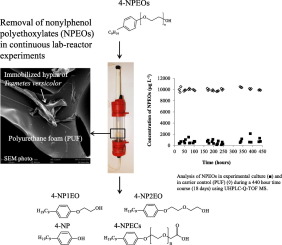当前位置:
X-MOL 学术
›
Sci. Total Environ.
›
论文详情
Our official English website, www.x-mol.net, welcomes your
feedback! (Note: you will need to create a separate account there.)
Removal of nonylphenol polyethoxylates by adsorption on polyurethane foam and biodegradation using immobilized Trametes versicolor.
Science of the Total Environment ( IF 8.2 ) Pub Date : 2020-03-26 , DOI: 10.1016/j.scitotenv.2020.138159 Åke Stenholm 1 , Mikael Hedeland 2 , Torbjörn Arvidsson 3 , Curt E Pettersson 2
Science of the Total Environment ( IF 8.2 ) Pub Date : 2020-03-26 , DOI: 10.1016/j.scitotenv.2020.138159 Åke Stenholm 1 , Mikael Hedeland 2 , Torbjörn Arvidsson 3 , Curt E Pettersson 2
Affiliation

|
Nonylphenol polyethoxylates (NPEOs) are banned in EU due to their endocrine disrupting properties. In a proof of concept study including continuous reactor lab-scale experiments, polyurethane foam (PUF)-immobilized Trametes versicolor was used to reduce the concentration levels of these compounds in an acidic nutrient solution over an 18-day period. Biodegradation and adsorption were identified as the major removal principles. A 90% removal was achieved by solely biodegradation in an experimental setup in which steady state conditions occurred, including NPEO-saturated glass and PUF surfaces. Biotransformation products containing mono- and di-ethoxylated nonylphenol, nonylphenol (NP1EO, NP2EO, NP) and nonylphenol polyethoxy carboxylates (NPECs) were tentatively identified. The maximum static NPEO adsorption capacity of PUF (determined with Erlenmeyer flask experiment) was calculated to 106 mg g-1, and the adsorption was described by the Langmuir isotherm equation. The corresponding maximum dynamic adsorption capacity (determined by continuous reactor experiment) was 100 mg g-1. These findings show that PUF is an excellent adsorbent to NPEOs. Therefore, PUF can either be used as a stand-alone adsorbent to NPEOs or as an immobilizing agent for Trametes versicolor through which a highly efficient biodegradation of these potentially harmful compounds can be achieved. The findings can be of importance in the search for alternative methods to remove NPEOs in process effluents.
中文翻译:

通过吸附在聚氨酯泡沫上并使用固定的云母Trametes进行生物降解来去除壬基酚聚乙氧基化物。
壬基酚聚乙氧基化物(NPEOs)由于其内分泌干扰特性而在欧盟被禁止使用。在包括连续反应器实验室规模的实验在内的概念验证研究中,聚氨酯泡沫(PUF)固定的Trametes versicolor被用于降低酸性营养液中这些化合物在18天的浓度水平。生物降解和吸附被确定为主要去除原理。在发生稳态条件(包括NPEO饱和的玻璃和PUF表面)的实验装置中,仅通过生物降解即可实现90%的去除率。初步鉴定了包含单乙氧基化和二乙氧基化的壬基酚,壬基酚(NP1EO,NP2EO,NP)和壬基酚聚乙氧基羧酸盐(NPEC)的生物转化产物。经计算,PUF的最大静态NPEO吸附容量(通过锥形瓶实验确定)为106 mg g-1,并用Langmuir等温方程描述吸附。相应的最大动态吸附容量(通过连续反应器实验确定)为100 mg g-1。这些发现表明,PUF是NPEO的极好吸附剂。因此,PUF既可以用作NPEO的独立吸附剂,也可以用作云芝Trametes的固定剂,通过它可以实现这些潜在有害化合物的高效生物降解。该发现对于寻找替代工艺废水中NPEO的替代方法可能具有重要意义。相应的最大动态吸附容量(通过连续反应器实验确定)为100 mg g-1。这些发现表明,PUF是NPEO的极好吸附剂。因此,PUF既可以用作NPEO的独立吸附剂,也可以用作云芝Trametes的固定剂,通过它可以实现这些潜在有害化合物的高效生物降解。该发现对于寻找替代工艺废水中NPEO的替代方法可能具有重要意义。相应的最大动态吸附容量(通过连续反应器实验确定)为100 mg g-1。这些发现表明,PUF是NPEO的极好吸附剂。因此,PUF既可以用作NPEO的独立吸附剂,也可以用作云芝Trametes的固定剂,通过它可以实现这些潜在有害化合物的高效生物降解。该发现对于寻找替代工艺废水中NPEO的替代方法可能具有重要意义。PUF既可以用作NPEO的独立吸附剂,也可以用作云芝Trametes的固定剂,通过它可以实现这些潜在有害化合物的高效生物降解。该发现对于寻找替代工艺废水中NPEO的替代方法可能具有重要意义。PUF既可以用作NPEO的独立吸附剂,也可以用作云芝Trametes的固定剂,通过它可以实现这些潜在有害化合物的高效生物降解。该发现对寻找替代方法以去除工艺废水中的NPEO可能具有重要意义。
更新日期:2020-03-27
中文翻译:

通过吸附在聚氨酯泡沫上并使用固定的云母Trametes进行生物降解来去除壬基酚聚乙氧基化物。
壬基酚聚乙氧基化物(NPEOs)由于其内分泌干扰特性而在欧盟被禁止使用。在包括连续反应器实验室规模的实验在内的概念验证研究中,聚氨酯泡沫(PUF)固定的Trametes versicolor被用于降低酸性营养液中这些化合物在18天的浓度水平。生物降解和吸附被确定为主要去除原理。在发生稳态条件(包括NPEO饱和的玻璃和PUF表面)的实验装置中,仅通过生物降解即可实现90%的去除率。初步鉴定了包含单乙氧基化和二乙氧基化的壬基酚,壬基酚(NP1EO,NP2EO,NP)和壬基酚聚乙氧基羧酸盐(NPEC)的生物转化产物。经计算,PUF的最大静态NPEO吸附容量(通过锥形瓶实验确定)为106 mg g-1,并用Langmuir等温方程描述吸附。相应的最大动态吸附容量(通过连续反应器实验确定)为100 mg g-1。这些发现表明,PUF是NPEO的极好吸附剂。因此,PUF既可以用作NPEO的独立吸附剂,也可以用作云芝Trametes的固定剂,通过它可以实现这些潜在有害化合物的高效生物降解。该发现对于寻找替代工艺废水中NPEO的替代方法可能具有重要意义。相应的最大动态吸附容量(通过连续反应器实验确定)为100 mg g-1。这些发现表明,PUF是NPEO的极好吸附剂。因此,PUF既可以用作NPEO的独立吸附剂,也可以用作云芝Trametes的固定剂,通过它可以实现这些潜在有害化合物的高效生物降解。该发现对于寻找替代工艺废水中NPEO的替代方法可能具有重要意义。相应的最大动态吸附容量(通过连续反应器实验确定)为100 mg g-1。这些发现表明,PUF是NPEO的极好吸附剂。因此,PUF既可以用作NPEO的独立吸附剂,也可以用作云芝Trametes的固定剂,通过它可以实现这些潜在有害化合物的高效生物降解。该发现对于寻找替代工艺废水中NPEO的替代方法可能具有重要意义。PUF既可以用作NPEO的独立吸附剂,也可以用作云芝Trametes的固定剂,通过它可以实现这些潜在有害化合物的高效生物降解。该发现对于寻找替代工艺废水中NPEO的替代方法可能具有重要意义。PUF既可以用作NPEO的独立吸附剂,也可以用作云芝Trametes的固定剂,通过它可以实现这些潜在有害化合物的高效生物降解。该发现对寻找替代方法以去除工艺废水中的NPEO可能具有重要意义。











































 京公网安备 11010802027423号
京公网安备 11010802027423号